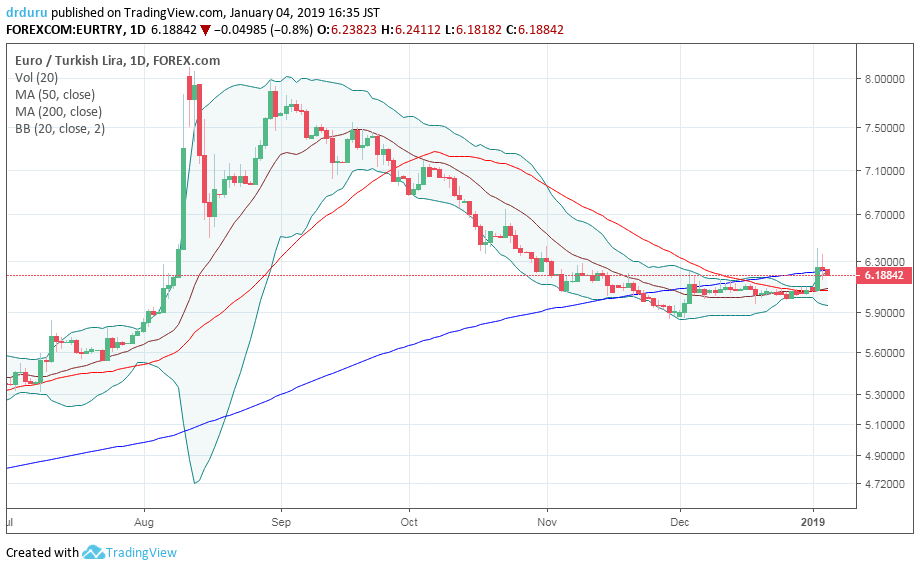In 2018, the Turkish lira experienced significant selling pressure. At one point in August, the currency went parabolic. USD/TRY gained as much as 34% in just three trading days from August 8th to the 12th. On August 13, 2018, the Central Bank of the Republic of Turkey (CBRT) responded with a laundry list of measures to defend the lira, including a notable reduction in reserve requirements. The lira immediately stopped its bleeding. However, in less than a week, sellers started pressuring the lira all over again. With USD/TRY climbing rapidly again, the CBRT took the unusual step of announcing it would take significant actions to defend the currency ahead of its upcoming policy meeting:
“Recent developments regarding the inflation outlook indicate significant risks to price stability.
The Central Bank will take the necessary actions to support price stability.Accordingly, in line with the previous communication, monetary stance will be adjusted at the September Monetary Policy Committee Meeting in view of the latest developments.
The Central Bank will continue to use all available instruments in pursuit of the price stability objective.”
This “threat” was enough to put an immediate end to the pressure on the lira. On September 13, the CBRT iced the deal with a massive increase in its policy rate (one week repo auction rate) from 17.75% to 24%. After initially dropping sharply, USD/TRY retraced all its losses and then some in four trading days. Gravity took over once more, and USD/TRY has declined ever since.
These actions were so dramatic that the October and December monetary policy decisions were met with relative yawns as the Turkish lira barely responded. Still, the ensuing two and a half months of lira strength (USD/TRY weakness) brought much needed forex relief for Turkey. The calm was so complete that the lira did not even respond to deepening weaknesses in global financial markets in October and November. Even the historic sell-off in U.S. stocks in December was only good for a 3-day rally in USD/TRY at the beginning of December. This week’s tumultuous start however finally stirred up fresh trouble for the lira in a move that looks like USD/TRY has finally reached a bottom.

As is the fate of so many parabolic moves, USD/TRY plunged after the August run-up. The eventual period of calm created a tension-filled convergence of its 20, 50, and 200DMAs. The resolution of the tension is so far a breakout to the upside.
Along with a “flash crash” type move in the Australian dollar (FXA) and Japanese yen (FXY), the Turkish lira suddenly weakened sharply. In less than 15 minutes, USD/TRY went from 5.40 to 5.66, a 4.8% surge. The resulting breakout for USD/TRY confirmed a likely bottom that could get a final test at the uptrending 200-day moving average (DMA).
The breakout pattern is not so clear against the euro (FXE) even as a bottom seems to be in place with EUR/TRY as well. While EUR/TRY rallied, the currency pair stalled around resistance from its 200DMA.

EUR/TRY followed the parabolic weakness and subsequent strength of the Turkish lira. The surge off recent lows did not qualify as a breakout as the 200DMA eventually won the battle of resistance.
The sudden awakening in the Turkish lira pairs caught me in the middle of trying to play the two off each other. After getting burned in the parabolic move of August, I did well collecting carry being short USD/TRY as it drifted downward. I rushed out the trade in late October when the pair looked ready for a fresh run-up. I returned to the trade in a hedged fashion and flipped the script going long USD/TRY and short EUR/TRY with various entries and exits. This week’s surge was the first time in a long while where I was able to flip a trade for a notable gain. A sell order on EUR/TRY triggered, and I was able to take profits hours later. At the same time, I decided not to take profits on my long USD/TRY; the decision was tough as I have grown weary of paying the carry on the position (the carry on short EUR/TRY does not cover the expense).
The lira is now in a race with the global economy. Inflation is still a problem in Turkey, and the CBRT must maintain tight monetary conditions. From the December policy decision:
“Recently released data show that rebalancing trend in the economy has become more noticeable. External demand maintains its strength while slowdown in economic activity continues, partly due to tighter financial conditions.
While developments in import prices and domestic demand conditions have led to some improvement in the inflation outlook, risks on price stability continue to prevail. Accordingly, the Committee has decided to maintain the tight monetary policy stance until inflation outlook displays a significant improvement.”
A weakening global economy will put pressure on the CBRT to loosen policy ahead of accomplishing its inflation goals. In turn, backing down from a tight monetary stance could send the lira on a significant weakening trend all over again. The bind for the CBRT is likely even worse than the bind gripping the U.S. Federal Reserve!
Be careful out there!
Full disclosure: long USD/TRY, short EUR/TRY, net long the Australian dollar and Japanese yen
